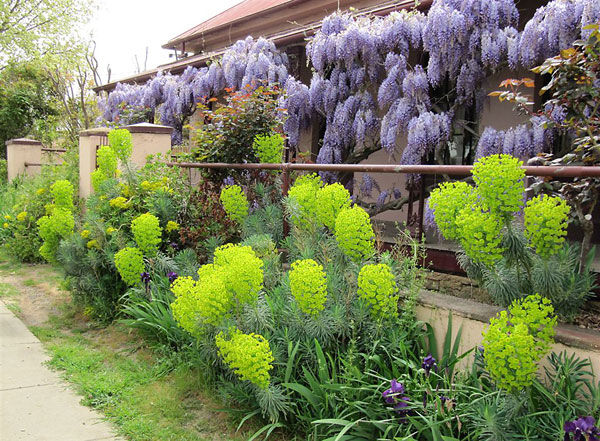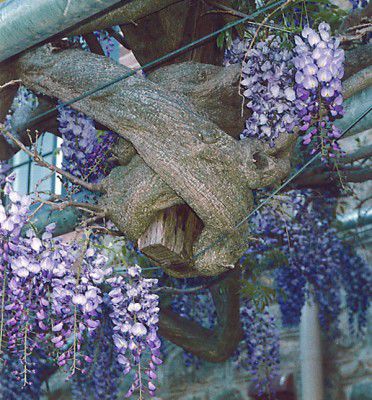
Pictured here is such a scene, on the front veranda of a late 19th century cottage, with wisteria growing in conjunction with Euphorbia wulfenii, a wonderful contrast.
Wisteria sinensis, or Chinese wisteria, has been cultivated in that country for more than 1500 years and admired as much for its blossoms as its dragon-like gnarled and twisted trunks.

American botanist Thomas Nuttall named wisteria after Caspar Wistar (1761-1818), a North American physician and early promoter of vaccinations.
Wisteria sinensis was introduced into Western gardens from Canton in 1816 and is possibly the most-popular variety, with stems twining anti-clockwise on posts.
Phillip von Siebold introduced Wisteria florabunda,or Japanese Wisteria, into Western gardens from Japan in 1830. This one twines clockwise on posts. An interesting peculiarity that, to my knowledge, no one can explain. You can try every method possible to make them go the other way, it just does not work.
Wisteria colours range from pure white to deep mauve/purple. To enjoy wisteria to its best is to grow it over a high, strong pergola or frame to allow the racemes to hang down and still be able to walk under the flowers.
I cannot emphasise enough the word strong as the trunk and stem can reach an incredible size as illustrated here. The wisteria was originally growing over a timber frame that collapsed under the weight of it, especially when in full flower. Note the small piece of remaining timber pergola encircled by the plant! As this was at an historic homestead, the timber frame was replaced with a strong, galvanised metal frame.
Get going on groundcovers
AT present, the ground is beautifully soft for weeding and planting. Think of ground covers as a living mulch; they will keep the ground moist, reduce evaporation and look considerably better than most mulches.
Let us consider a few suggestions starting with carpet thyme, such as Thymus “Doone Valley”. I recommend this as some thymes such as the culinary Thymus Westmoreland, or Turkey Thyme, can grow to 40cm tall.
An extremely ground-hugging, living mulch is Dymondra margaretae with silver grey variegated foliage and tiny yellow flowers.
Ajuga “Catlin’s Giant” is in flower in gardens and garden centres with its deep blue spikes of blooms 25-30cm high.
Parahebe “Oxford Blue” is one of the real delights in our garden mixed in with Phlox subulatus. Do not confuse this variety with Phlox paniculata, which grows from 75cm-90cm high.
Let us not forget Rosmarinus prostratus, the ground cover rosemary or Scaevola “Mauve Clusters” or Scaevola aemula “Summer Blues”.
I suggest you plant most ground covers about 40cm-50cm apart. One of the most vigorous ground covers is the great Aussie Myoporum parvifolium with fine leaves and a mass of tiny white flowers. This is a real toughie and will even grow well under gum trees as is evidenced under our Eucalptus Nicholii on the nature strip. This is just a small selection to get the thought processes going for living mulches.
Who can be trusted?
In a world of spin and confusion, there’s never been a more important time to support independent journalism in Canberra.
If you trust our work online and want to enforce the power of independent voices, I invite you to make a small contribution.
Every dollar of support is invested back into our journalism to help keep citynews.com.au strong and free.
Thank you,
Ian Meikle, editor



![Evie Hudson is a woman with amnesia, who forgets the last 13 years. Piecing her life back together, she navigates the harsh realities of coercive control.
Evie is the leading character in local author @emmagreyauthor's second novel Pictures of You.
Her debut book, The Last Love Note, sold more than 100,000 books worldwide within a few months of being published last year.
“I think that using amnesia really helped [show the effects of coercive control] because she had that sense of being completely lost in her own life,” Emma says of her new work of fiction.
To read the full story and find out more about this fabulous local author and her latest novel, visit our website at citynews.com.au or click the link in our bio! 📚✒️
#canberra #local #canberralocals #canberralife #australia #author #localauthor #Picturesofyou #coercivecontrolisabuse #dvawareness #bestsellingauthor #canberraauthor #localnews #citynews](https://citynews.com.au/wp-content/plugins/instagram-feed/img/placeholder.png)
Leave a Reply